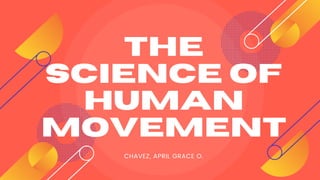The Science of Human Movement in Physical Education
•Download as PPTX, PDF•
0 likes•87 views
Pathfit 2 Fitness Exercise
Report
Share
Report
Share

Recommended
More Related Content
Similar to The Science of Human Movement in Physical Education
Similar to The Science of Human Movement in Physical Education (20)
Discuss throw SPECIFIC EXERCISES AND ANALYSIS OF THROWING TECHNIQUE

Discuss throw SPECIFIC EXERCISES AND ANALYSIS OF THROWING TECHNIQUE
Recently uploaded
Antibiotics are medicines that fight infections caused by bacteria in humans and animals by either killing the bacteria or making it difficult for the bacteria to grow and multiply. Bacteria are germsABHISHEK ANTIBIOTICS PPT MICROBIOLOGY // USES OF ANTIOBIOTICS TYPES OF ANTIB...

ABHISHEK ANTIBIOTICS PPT MICROBIOLOGY // USES OF ANTIOBIOTICS TYPES OF ANTIB...ABHISHEK SONI NIMT INSTITUTE OF MEDICAL AND PARAMEDCIAL SCIENCES , GOVT PG COLLEGE NOIDA
HIV (human immunodeficiency virus) is a virus that attacks cells that help the body fight infection, making a person more vulnerable to other infections and diseases. It is spread by contact with certain bodily fluids of a person with HIV, most commonly during unprotected sex (sex without a condom or HIV medicine to prevent or treat HIV), or through sharing injection drug equipment.
Seasonal influenza (the flu) is an acute respiratory infection caused by influenza viruses. It is common in all parts of the world. Most people recover without treatment.
Influenza spreads easily between people when they cough or sneeze. Vaccination is the best way to prevent the disease.
Symptoms of influenza include acute onset of fever, cough, sore throat, body aches and fatigue.
Treatment should aim to relieve symptoms. People with the flu should rest and drink plenty of liquids. Most people will recover on their own within a week. Medical care may be needed in severe cases and for people with risk factors.
There are 4 types of influenza viruses, types A, B, C and D. Influenza A and B viruses circulate and cause seasonal epidemics of disease.
Influenza A viruses are further classified into subtypes according to the combinations of the proteins on the surface of the virus. Currently circulating in humans are subtype A(H1N1) and A(H3N2) influenza viruses. The A(H1N1) is also written as A(H1N1)pdm09 as it caused the pandemic in 2009 and replaced the previous A(H1N1) virus which had circulated prior to 2009. Only influenza type A viruses are known to have caused pandemics.
Influenza B viruses are not classified into subtypes but can be broken down into lineages. Influenza type B viruses belong to either B/Yamagata or B/Victoria lineage.
Influenza C virus is detected less frequently and usually causes mild infections, thus does not present public health importance.
Influenza D viruses primarily affect cattle and are not known to infect or cause illness in people.HIV AND INFULENZA VIRUS PPT HIV PPT INFULENZA VIRUS PPT

HIV AND INFULENZA VIRUS PPT HIV PPT INFULENZA VIRUS PPTABHISHEK SONI NIMT INSTITUTE OF MEDICAL AND PARAMEDCIAL SCIENCES , GOVT PG COLLEGE NOIDA
Recently uploaded (20)
MSC IV_Forensic medicine - Mechanical injuries.pdf

MSC IV_Forensic medicine - Mechanical injuries.pdf
ABHISHEK ANTIBIOTICS PPT MICROBIOLOGY // USES OF ANTIOBIOTICS TYPES OF ANTIB...

ABHISHEK ANTIBIOTICS PPT MICROBIOLOGY // USES OF ANTIOBIOTICS TYPES OF ANTIB...
HIV AND INFULENZA VIRUS PPT HIV PPT INFULENZA VIRUS PPT

HIV AND INFULENZA VIRUS PPT HIV PPT INFULENZA VIRUS PPT
Factor Causing low production and physiology of mamary Gland

Factor Causing low production and physiology of mamary Gland
Information science research with large language models: between science and ...

Information science research with large language models: between science and ...
Mining Activity and Investment Opportunity in Myanmar.pptx

Mining Activity and Investment Opportunity in Myanmar.pptx
Adaptive Restore algorithm & importance Monte Carlo

Adaptive Restore algorithm & importance Monte Carlo
Efficient spin-up of Earth System Models usingsequence acceleration

Efficient spin-up of Earth System Models usingsequence acceleration
Vital Signs of Animals Presentation By Aftab Ahmed Rahimoon

Vital Signs of Animals Presentation By Aftab Ahmed Rahimoon
The Science of Human Movement in Physical Education
- 1. THE SCIENCE OF HUMAN MOVEMENT CHAVEZ, APRIL GRACE O.
- 3. BIOMECHANICS AND BODY MOVEMENTS • THE TYPE OF MOVEMENT THAT CAN BE PRODUCED AT A SYNOVIAL JOINT IS DETERMINED BY ITS STRUCTURE TYPE. • IS THE SCIENCE OF MOVEMENT OF A LIVING BODY. INCLUDING HOW MUSCLES BONES,AND LIGAMENTS WORK TOGETHER TO PRODUCED SUCH MOVEMENTS.
- 4. FUNDAMENTAL HUMAN MOVEMENTS • PULL • PUSH • SQUAT • LUNGE • HINGE • ROTATION • GAIT
- 6. SQUAT Considered to be the most complex movement the human body is capable of. Squat targets the glutes, core quadriceos and to a slight degree, the harmstring muscles. LUNGE A long linear stride, lowering your back knee to just above the ground, with a completely upright torso.
- 7. this is your ability to ratate that involves twisting at the core. The core ( specially the obligue ) is the main contributor to this set of movements. It can be performed bodyweight or in dozens of other varietion including the deadlift. Bend to extend movements work on your glutes, harmstring, and lower back. HINGE ROTATION
- 8. This is the technique of walking , jogging, running or sprinting. GAIT
- 10. Bending of the body segment. Moving a limp away from the body. Straightening of body segment. flexion abduction extension
- 11. • Extension (flex knee) • Flexion (flex knee) • Extension ( straight leg ) • Flexion ( straight leg ) • Abduction • Adduction • Abduction • Adduction • Flexion • Extension • Internal Rotation • External Rotation Flexibility MOVEMENT SHOULDER: HIP:
- 12. • Flexion • Extension Flexibility MOVEMENT KNEE : Ankle : • Dorsi Flexion • Plantar Flexion TRUNK: • Flexion • Extension • Rotation • Lat. Flexion
- 14. thank you for listening !